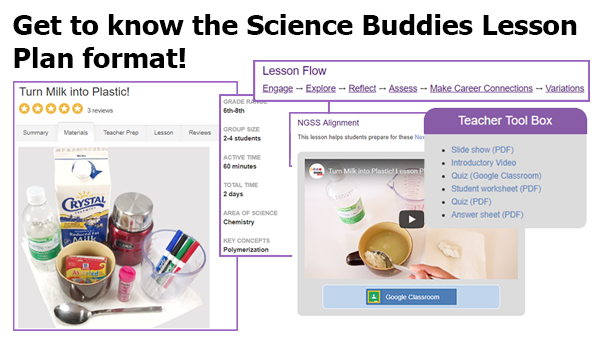How to Use a Science Buddies Lesson Plan
Science Buddies has 100+ NGSS-aligned lesson plans that are free to use for K-12 STEM educators. Walk through a sample lesson to see how they work!
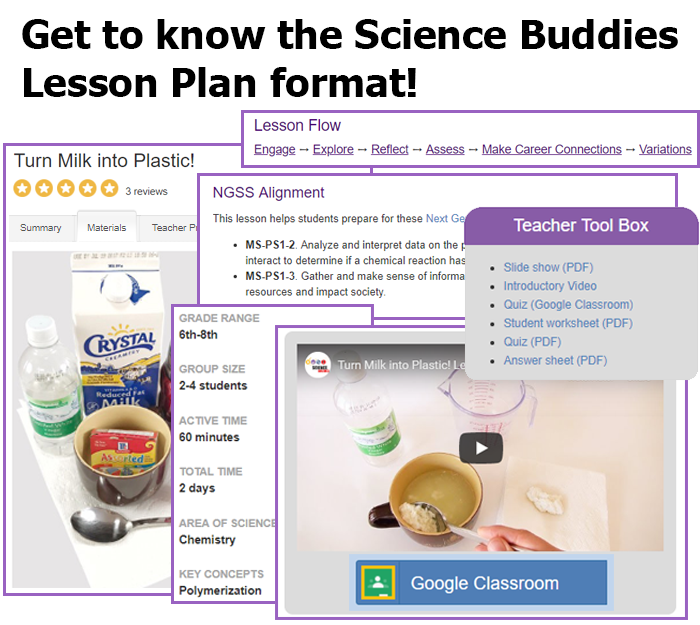
A collage of screenshots show a materials page for a project turning milk into plastic on the website ScienceBuddies.org. Other screenshots show NGSS alignment details, project details, links in a Teacher toolbox, links to a lesson plan and a related video.
Science Buddies Lesson Plans blend our dedication to hands-on science, technology, engineering, and math (STEM) exploration with background materials designed to help teachers lead classroom STEM activities with confidence, regardless of prior experience with the subject. The result is a flexible, end-to-end solution that takes teachers from choosing and planning a NGSS-aligned activity to leading in-class discussion, walking students through a group experiment, discussing outcomes, and assessing student learning.
All Science Buddies Lesson Plans are aligned with Next Generation Science Standards (NGSS) to help teachers plan hands-on classroom science activities that meet NGSS objectives.
A Lesson Plan Walkthrough
Lesson Plans have been carefully structured to provide a great deal of information within an easy-to-use format. In this post, we will use the Turn Milk into Plastic! Lesson Plan as an example for an in-depth walk-through of our standard Lesson Plan format.
Lesson Plans are located in the Hands-on STEM for Your Classroom section of the Science Buddies site and can also be found using the filters available for the Science Buddies search engine.
Each Lesson Plan uses a system of navigation "tabs" that contain information related to preparing and teaching the lesson. Each of these tabs is described in detail below. (Note: due to length, some sections of the lesson have been abbreviated in the images below.)
Summary
When you visit a Science Buddies Lesson Plan, you begin on the Summary tab. This main screen offers a brief overview of the STEM lesson, provides the NGSS-alignment information, and features a short video or picture of the activity:
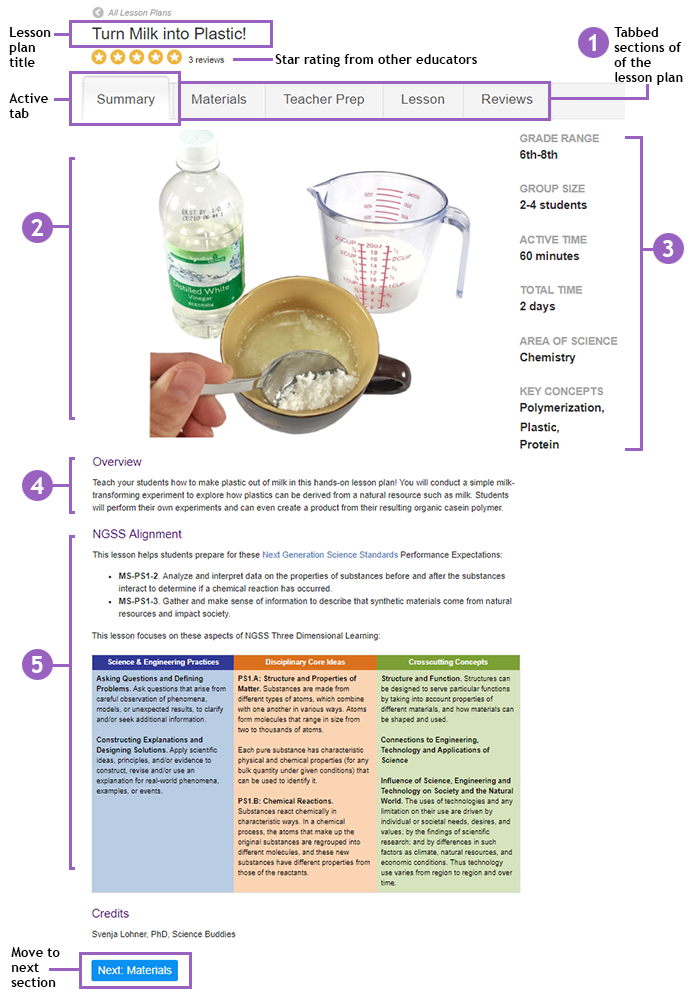
A screenshot of a project summary page on the website ScienceBuddies.org shows a lesson title, project rating, navigation bar, example project image, project details, project summary and an NGSS alignment rubric. The project title, rating and navigation bar are at the top of the page, below that is a project image and project details to the right of the image, then below that is the project overview and NGSS alignment. At the bottom of the page is a button that links to the next page in the project navigation bar.
The screenshot above highlights the location of the following information available on the Summary tab:
- Tabs: the tabs allow you to access the core sections of a Science Buddies Lesson Plan. The Teacher Prep and Lesson tabs are not accessible to students. Note: the tab for the section you are currently viewing is bigger than the other tabs and is highlighted.
- Video or photo: an introductory photo or video provides a short and engaging visual overview of the activity. (For Lesson Plans that contain a video, Google Classroom teachers can assign the video to students directly by using the Google Classroom button.)
- Summary box: the summary box (on the right) notes the target grade level, the amount of time required for the activity, the key area(s) of science, and important concepts covered in the activity. This information is especially helpful for teachers as they search for and schedule in-class activities to meet their curriculum needs.
- Overview: the short overview statement describes the objective and science principles covered in the lesson.
- NGSS: the NGSS-alignment for the lesson notes performance objectives and aspects of NGSS Three Dimensional Learning covered in the activity. (Note: the color-coding of the Three Dimensional learning system is continued in other parts of the lesson.)
At the bottom of each tabbed section, a "next" button is available to guide you through the lesson plan. (Alternately, you can use the tabs at the top of the page to jump directly to the different sections of the lesson.)
Materials
On the Materials tab, teachers will find a full list of required (and optional) materials for the activity, including any notes regarding materials for groups versus general materials needed.
Teacher Prep
The Teacher Prep tab contains information to help an educator get ready to teach the lesson in the classroom. The key elements of this section are shown below:
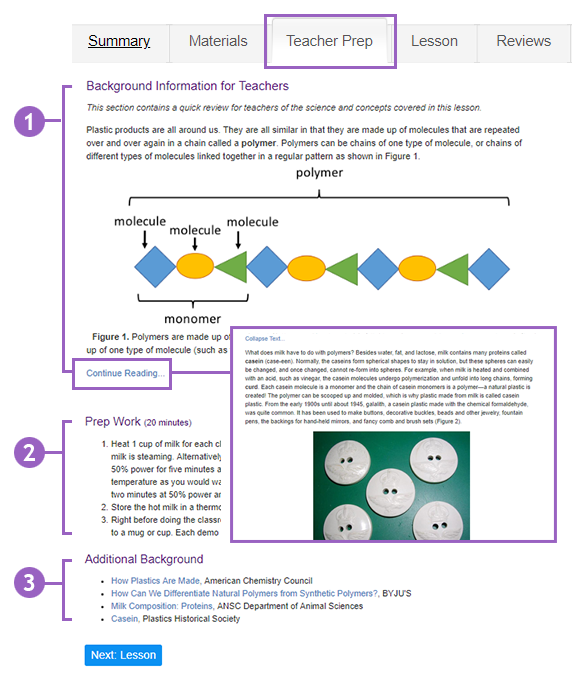
A screenshot of a teacher prep page for a project on the website ScienceBuddies.org shows background information for the project with example images, a list of prep work and links to additional information about the project.
- Background Information for Teachers: this information provides teachers with a comprehensive explanation of the science covered in the lesson. This information is designed to build confidence for a teacher who has not taught a lesson in this area of STEM. It also functions as a science refresher for educators who may have taught similar lessons before. When you first open the Teacher Prep tab, some of the background information is hidden from view. Click the "Continue Reading" link to expand the background material. When finished, click the "Collapse Text" link to hide it from view.
- Prep Work: this section describes the steps an educator needs to take in advance before teaching the lesson with students. An estimate of the time required is provided to assist with planning.
- Additional Background: this list contains a curated set of additional resources for further reading.
Lesson
The Lesson tab contains materials to guide the in-class activity, including discussion, reflection, and assessment. The key elements of the Lesson tab are highlighted in the screenshot below:
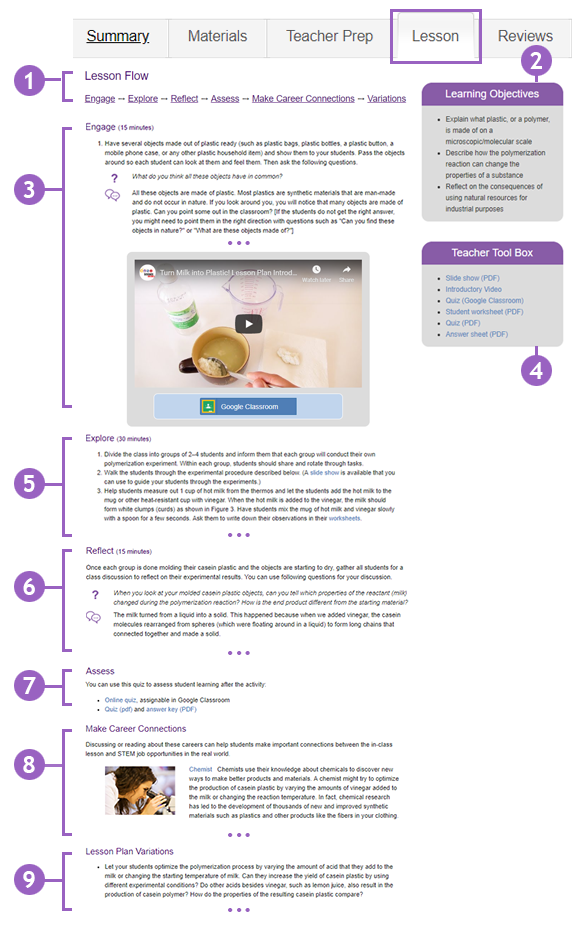
A screenshot of a lesson page for a project on the website ScienceBuddies.org shows 6 sections of a lesson flow plan, learning objectives, and links in a teacher tool box. The learning objectives and teacher tool box are listed in side bars on the right of the page. The rest of the page contains 6 sections of a lesson plan (from first-to-last): Engage, Explore, Reflect, Assess, Make Career Connections and Variations.
- Lesson Flow: the lesson is presented in a sequential format that guides educators from start to finish. The "Lesson Flow" links at the top of the page allow educators to jump to specific sections of the lesson, as needed. The Lesson Flow includes the following sections: Engage > Explore > Reflect > Assess > Make Career Connections > Variations.
- Learning Objectives: the learning objectives for the activity are shown in a box on the right. This bulleted list provides a concise overview of the lesson's educational goals.
- Engage: this section contains guided discussion questions to begin the lesson. To help facilitate in-class discussion, sample questions (marked with the "question mark" icon) and answers (marked with the "speech balloons" icon) are provided. (Note: sample question/answer pairs are provided throughout the lesson to aid in class discussion.) This section may also contain additional introductory information, including a related video or video overview. (Google Classroom teachers can use the Google Classroom button to assign the video to students.)
- Teacher Tool Box: this box on the right contains links to the student worksheet and any supplemental resources available for use during and after the activity. Supplemental materials vary by lesson and may include resources like a downloadable presentation or slideshow, an informational handout, or assessment materials. Worksheets and other downloadable content are provided in PDF format. Quizzes can be assigned for online use with Google Classroom or can be printed in PDF format. An educator answer key is provided.
- Explore: this section contains the steps of the in-class activity. The activity is written for teachers to convey directions to students and works alongside the worksheet for the activity.
- Reflect: this section contains sample question and answer pairs to prompt students to reflect on what they observed and learned from doing the activity. Discussion in this section may include reflection on the activity as well as forward-looking discussion about future exploration.
- Assess: this section contains links to the assessment materials (also available in the Teacher Tool Box).
- Career Connections: to promote student awareness of STEM career paths, this section highlights STEM careers that are relevant to the lesson. A summary of the career that concretely explains how the career is related to the lesson is provided. Teachers can use these career connections to inspire additional career research and reading among students using the Science Careers area at Science Buddies.
- Lesson Plan Variations: this section contains suggestions for ways in which teachers can alter and/or extend the lesson by changing the setup, trying additional materials, or expanding the focus. Variations can be used to scale an activity for a specific class, modify an activity for a specific focus, or conduct a related follow-up exploration.
Color-coded NGSS alignment
All Lesson Plans show NGSS alignment on the Summary tab, as shown above. Most Lesson Plans also mark specific areas of NGSS alignment within the lesson using a system of color-coded highlighting.
When viewing the information on the Lesson tab, for example, you may see lines highlighted in orange, blue, or green, as shown in the screenshot below:
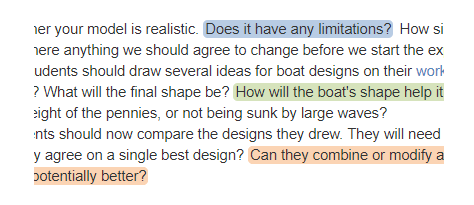
A cropped screenshot of highlighted text from a lesson plan on a project page on the website ScienceBuddies.org. Certain text from a paragraph is highlighted in specific colors based on their relation to NGSS.
The color of the highlight relates to the aspects of NGSS Three Dimensional Learning addressed in the lesson. (Remember, the table showing this information is on the Summary tab.) When you hover your mouse over any highlighted line, context-specific information about the NGSS aspect pops up in a small color-coded window. When you move your mouse away, the popup disappears.
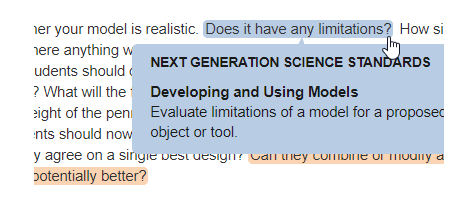
A cropped screenshot of highlighted text from a lesson plan on a project page on the website ScienceBuddies.org. Certain text from a paragraph is highlighted in specific colors based on their relation to NGSS. When the highlighted text is selected a pop-up shows details of the NGSS alignment.
Accessing Lesson Plans
Summary information and the required materials for a Lesson Plan are visible to all users of the Science Buddies site. Accessing the Teacher Prep and Lesson tabs, however, requires being logged in with a non-student account. In addition, teachers who are logged in as Google Classroom teachers have the ability to use the Google Classroom button to assign parts of the Lesson Plan, like videos and the online quiz.
For more information about using Google Classroom with Science Buddies, see our Google Classroom area.
Share Your Science Buddies Story!
Have you used a science project, STEM activity, or Lesson Plan from Science Buddies in your class or program? We would love to hear your story! Email us at scibuddy@sciencebuddies.org and tell us how you use Science Buddies with students.
A collage of screenshots show a materials page for a project turning milk into plastic on the website ScienceBuddies.org. Other screenshots show NGSS alignment details, project details, links in a Teacher toolbox, links to a lesson plan and a related video.
Categories:
You Might Also Enjoy These Related Posts:
- Forces and Laws of Motion Lessons
- Curated STEM Resources for Teaching Science Units
- 15+ Plant Science Activities and Lessons / Teach Plant Biology
- 13 Activities and Lessons to Teach Potential and Kinetic Energy
- 200 Free Lesson Plans for Science and Engineering
- 2020 Nobel Science Experiments for K-12 Students
- Teaching Biotechnology at All Grade Levels
- Free STEM Lessons that Work Well for Remote Learning


